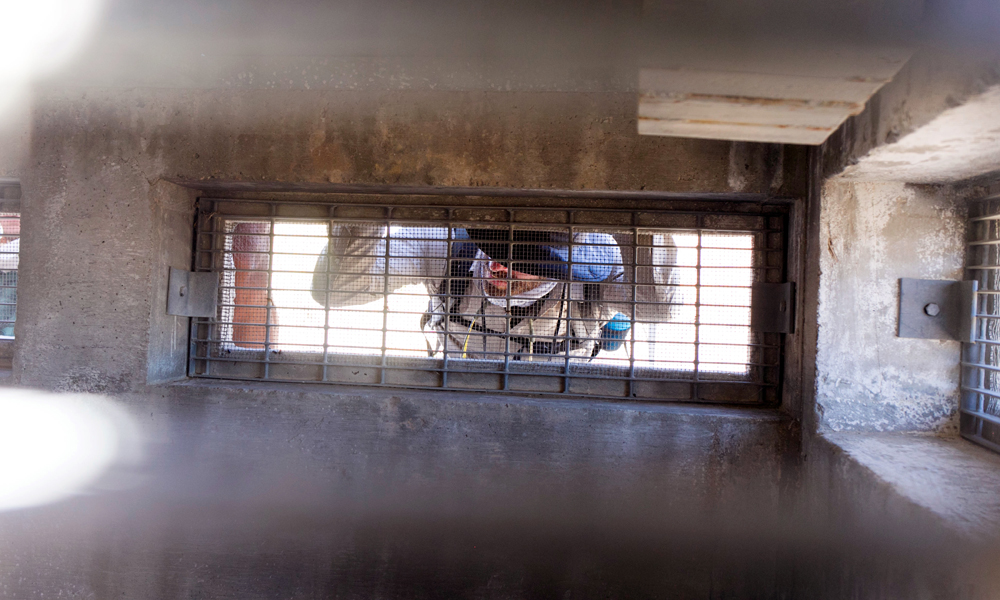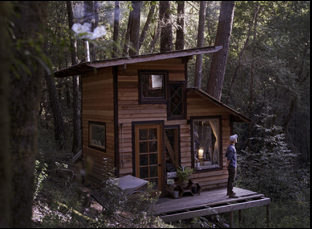For many cuts of “Reflection: a walk with water,” Emmett Brennan was reluctant to include himself in the film, despite the advice of people who had seen it and who knew him suggesting that it needed his voice. After all, he had already committed himself to the 200-mile trek on foot alongside the Los Angeles aqueduct with the consciousness-raising organization Walking Water, so he was inherently part of the film, but there was another consideration as he was beginning to build a more sustainable house for himself in the forest of Sebastopol.
“I didn’t want to take attention away from all the people in this film who really are the ones that have the things to share, but it did need me as a through line,” Brennan said, on the eve of the film’s premiere at Tribeca. “And I was building this house at the same time as I was editing the film, so there was just this mysterious weaving of those two things. My creative process for the film and building this house were so similar and I was learning a lot about how I’m a creative person and I love that this film and this house ended up being featured as it is in the film.”
One is allowed to marvel at the mini-manse that Brennan has set up for himself in the woods where all his tap water is from naturally occurring resources, but the point of “Reflection” is that anyone is capable of doing it if the will is there and the filmmaker has made a compelling case for why conservation is a more attainable goal that most would think when a growing network of people are finding ways to collectively counter what is currently an inefficient dispersal of what water there is. While wildfires in Northern California drove Brennan towards finding more conscientious living arrangements, he looks at how the climate crisis is only part of what’s wreaking havoc on what has long been a stable ecosystem as droughts have been more common but the use of water has been draining in a different way, with more and more invention required to rethink the best allocation of it.
“Reflection: a walk with water” inspires by profiling people who have risen to the challenge, creating savvy solutions to feeding their plants and keeping their showers running and with Brennan leading by example, in addition to providing many others, the film makes change feel as if it’s within reach. With the film debuting at Tribeca, Brennan spoke about how he made a more personal film than he ever could’ve expected with his latest, telling a story of water when there wasn’t a whole lot of it to film and packing light in order to capture his journey.
The film came about because I’m full of grief and rage and confusion about the state of our world right now — environmentally, socially, and all the things, but in this case, environmentally. As a filmmaker, I was drawn to tell a story that could support this moment we’re in and as I started digging into things, I just realized how much water is at the foundation of so much of the unraveling that’s occurring and and the species extinction and the domestication of our ecosystems, so I felt I had the space and the opportunity to tell a story that might help and I started to find people who are doing really good work with water and changing the paradigm of our thinking on it.
This seems to be an extension of your earlier film “Inhabit: A Permaculture Perspective” – how did you get interested in this area of changing your living habits around nature?
Growing up, I had a forest by my house and spent a lot of time [there] with friends, but I didn’t grow up really learning how to have a relationship with land or what that even means. At some point when I was coming into adulthood, I just realized that some emptiness in me was coming from this disconnection to place and not knowing how to actually interact with land and how to grow food or do these very basic human things that are so far away from so many of us now. Being exposed to certain people in my life who were holding that kind of energy and knew how to care for land, it just hit me deeply and it made me want to move towards that and learn how to connect myself.
Was the water walk always going to be the backbone for the film?
Yeah, that walk was going to be some heartbeat, and I was working with my former partner on this and we didn’t really know what the film was going to be. We were really just tossing things out and seeing what made sense to film, waiting for the next connection. But there is a real spiritual core of this pilgrimage along the L.A. Aqueduct, following the water from the source in the Eastern Sierras back to LA for 200 miles and learning the history of that land that was [tended to] by the indigenous people for thousands of years. That valley which was once lush with life is now a desert and what that means globally for the climate [with] these patterns of small water cycles and why we’re having so many climate irregularities, that walk just contains so much of the picture of our planet, so it ended up being a really nice poetic way to weave through the film.
Was it difficult to film when you were lugging equipment around for that entire walk?
We had a really small rig, just little Sony DSLRs and we had these cool solar panels that would just hang off the back of our bags or to charge batteries as we went and just one lens each. There were two of us filming, and your body gets used to the weight over time. My body got used to the weight at some point. Looking back, I’m like, how the heck did that even work out? It feels so overwhelming that we did that, but it just happened and we made it work.
When there’s so much dry land, what’s it like figuring out visually what the presence of water in the film would be?
There was a time where I was like, “this film was about water and there’s not that much water in the film.” There’s definitely more water now, but even still, the projects that we were filming are trying to remediate the issue of losing water from our landscapes and the changing climate that’s bringing less rain, so it was interesting to have a film be about water, but have the absence of water.
The animation is also a beautiful way to articulate the situation. How did it come about?
At one point, I was thinking maybe half this film is going to be animated and I’ll have all these stories animated, and I worked with [Fiona Lee MacLean] in Vermont who did the illustration and then [Jordan Booker] the animator in Australia and we were on three different time zones, so it was hard to sync us all up. But I fell in love with this woman’s illustrations a couple of years ago — she does children’s story books and there’s just something very whimsical and also ecological about her work. One of the things that I have attempted to do with this film is to open people’s imaginations and hearts to the beauty and mystery of what’s possible and I felt like having animation in there was a good way to tickle that imaginative quality.
Was there any directions this took that you might not have been expecting, but something changed your ideas about what this could be?
Yeah, it’s hard working on a project for over five years because I changed so much as an individual yet the content of the film has essentially stayed the same, so how do you keep the growth curve aligned as an individual and then as the project and how do you keep the project moving with you as you’re growing and your interests are changing? There was a point where the film was just totally not working for me and I was bored of it. It wasn’t feeling alive in me anymore, and I started to rewrite the script and actually make it a love story/story about water because my partner and I broke up during the filming of this and that was a really important thing to go into because it just opened my whole paradigm of what was possible in this story. Then eventually [I realized], “No, that’s not the story to tell.” But it opened a door for me to have it become more of a love letter for water, and it just brought me back into how much I cared about this project and it allowed me personally to deepen my relationship with water. It’s like I had to let the message of the film work me in order to finish it.
In spite of all of that, was it easy to stay positive? The water situation grows increasingly more dire by the day yet this is refreshingly solution-based.
Yeah, that was definitely there from day one. I had actually started to work on this short-form episodic series idea where I wanted to meet all sorts of people across different genres of work who are doing good things and in that process of mapping out and brainstorming what that project would be, I just realized how much water was at the foundation of all of their work, so a series of things happened that made want to hone in on a feature-length documentary because it seemed like water was a good way to just hit it all in some ways.
What’s it like getting to the finish line with this?
This final stretch has been absolutely stressful [because] it’s like a birth canal. There’s a lot of pain in pushing this out, but right now I’m starting to really let in the celebration and clean my eyes and look around and be like, “Oh yeah, this is really happening.” This has been a long journey and what an amazing platform were getting to premiere the film at Tribeca and to have so many people coming and adding to the team. It’s really remarkable. I’m super grateful and can’t wait for the experience of sharing it with people.
When you say adding to the team, is there actually a way for people to learn more about the cause or take action?
That’s totally the heart of the intention with this film is how can this film be put to use fundamentally. We’re still figuring out [an impact campaign], but one of the places to begin is Los Angeles because it’s just so much a feature of the film and because one of the [subjects] in the film sits in roundtables with the mayor and with the head of department of water and power and head of sanitation, all these governmental bodies that run the city, and he has relationships with them, so I think if we could start hosting some events and bringing people like that together with community members and activists and scientists and just initiate dialogue, that’s a really good place to begin and that’s something I’d like to replicate all over, hosting screenings where we can bring different people with different interests together to talk and say, what can we do? How can we move forward? And what are we missing right now?
“Reflection: a walk with water” is available to stream via the Tribeca Film Festival through June 22nd.





